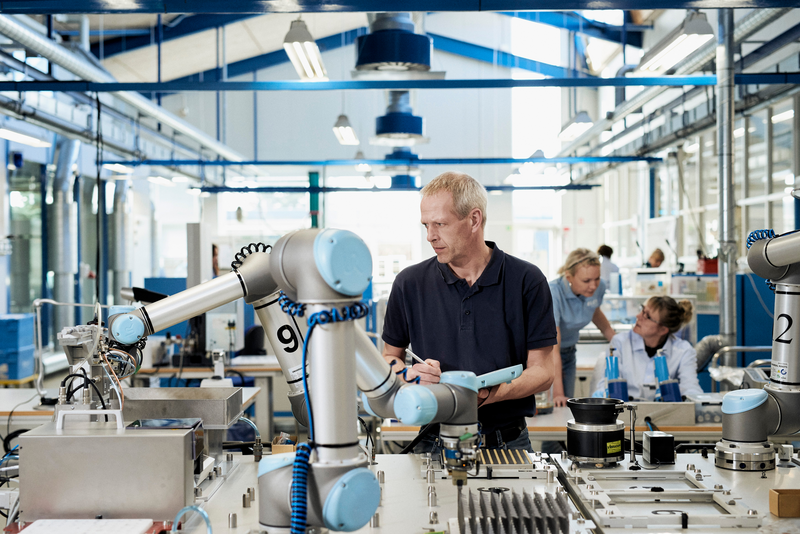Voice Commands for Robot Programming? Konica Minolta’s New CoboVox
Starting as an exciting novelty that has gained a foothold in many consumer technologies, voice control has struggled with industrial traction, but Konica Minolta has a new method of programming robotics.
The phrase ‘easier said than done’ is nowhere more plainly obvious than when applied to an industrial electrical setting. It’s easy to speak words to a machine, but there is an astounding level of technology involved with hearing the sounds from our various human voices, interpreting them into text, realizing the meaning of the text, then finally translating that context as meaningful commands.
A number of breakthroughs in recent years (particularly AI processing capabilities) have allowed innovations in voice-to-action technology. Konica Minolta, a multi-technology company hailing from Japan, has launched a voice-driven application for programming robotics, most notably securing a partnership with collaborative robot (cobot) leader Universal Robots.

CoboVox allows programmers to design, edit, and run a program without advanced programming experience. Image used courtesy of Universal Robots
What Is CoboVox?
Imagine you need to design a new program for a robot. You pick up the teach pendant, but after only a little bit of exposure to robots, you can’t seem to find the menu button that saves the current waypoint in the program. Wouldn’t it be nice if you could simply say, "Please save this as waypoint 1"?
That’s exactly the description of CoboVox.
Integrated into the URe series of cobot controllers from UR as part of the UR+ application kit ecosystem, this application opens the door to easier, more intuitive programming methods. It allows the programmer to design, edit, and run the program without the necessity of background knowledge in advanced programming.
This application is not designed to allow the operator to have an entirely hands-off experience. Cobot programming involves hand-guiding the robot to a specific position with a certain ‘pose’ angle of the tool before saving the waypoint. This guidance is still necessary for teaching. The benefit of a voice-activated method is that it allows the programmer to move the robot to a position quickly, ask for the point to be saved, then move to the next position without moving between the teach pendant and the robot.
The CoboVox application does not simply hear commands—it also responds. This can be useful for two main reasons. First, the voice can guide the programmer through the steps, prompting the user to move to a home position, then through an entire motion path, specifying joint or linear moves, override speeds, gripper commands, etc., until the program is complete. The other benefit of response is the assurance that commands were properly understood. Similarly to asking someone to repeat what they heard, you can verify that the command was received and recognized properly in real time.

A human operator is still necessary to jog and manipulate the robot being programmed. Image used courtesy of CoboVox
CoboVox Hardware Integration
Although programming the robot itself is an important component, the hardware external to the robot must also be considered. This includes the tooling attached to the robot (the EoAT) as well as the voice input required to receive the commands from the programmer.
The system is designed to recognize a number of common gripper commands, including 'open', 'close', and other terms such as 'activate' if the tool is not an open/close style of motion. Access to all digital ports, both the controller and tool I/O ports are accessible by the system to be commanded on/off or to be used in the program flow to wait for digital signals, or to choose program paths based on incoming signals.
To interface with the CoboVox, a PC connects to the robot controller. Since most laptops include microphones and speakers, these can easily integrate with the robot. If external microphones are required, the developer team can provide lists of recommended models for best performance.
Challenges for Voice-Controlled Automation
It would be quite an assumption to state that voice control could be used to accomplish any programming task. Anyone with speech recognition experience knows that a few obstacles can hinder efficient voice control applications.
One challenge is the context difference between a human user and a logical computer. This could be easily illustrated when trying to imagine jogging a robot. As the user moves around the table, they may ask the robot to “move 6 inches to the right.” However, the robot may misinterpret right and left. To correct this problem, the programmer might say, “Move 6 inches in the positive x direction”, which is certainly a recognized command for the CoboVox system, but something motion requires a constant knowledge of the coordinate system, and this would be extremely difficult to predict diagonal or circular moves.
For this reason, the CoboVox solution does not remove the human operator. That programmer is still necessary for jogging and manipulating the robot.
Another challenge is the interpretation of accents, voice pitches, and volumes. Every person speaks with different sounds; that’s one of the things that makes us human. This individuality poses huge challenges for accurate voice translation. However, those challenges are far less extreme than they used to be.
More advanced analytical tools allow computers to detect subtle differences in voices—differences in tone, volume, language, and dialect- that allow the computer to better interpret what each human is saying. (Just for fun and to prove a point, I just used my computer to type that last sentence with speech-to-text, with no example sentence or training required.)

CoboVox's voice-controlled cobot programming allows nearly anyone to launch a UR automation platform with relative ease. Image used courtesy of CoboVox
Voice Control for Automation
It is likely that machines will always encounter some challenges when working with people, especially when it comes to voices and actions since we are all so different. However, technologies like CoboVox from Konica Minolta can provide guidance and accessibility to novice users, allowing virtually anyone to launch a UR automation platform with ease and reliability.






